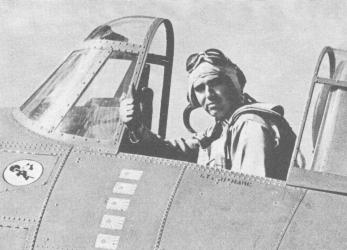 |
|---|
| Edward H. (Butch) O'hare |
 |
|---|
| Edward H. (Butch) O'hare |
The role of the fighter pilot aboard an aircraft carrier at sea is the same
as that of a fighter pilot anywhere: to win and hold control of the air. Until
he does this, his own base--the carrier--is not safe. And the important bombers
and torpedo planes the ship carries may not be able to get through the enemy
fighter screens with their lethal loads.
To be successful, the fighter
pilot had to master more tasks than any other single man in World War II. He had
to be exceptionally good, of course, at handling a fighter plane--alert, with
superior coordination and split-second timing. There was an unprecedented amount
of technical know-how to absorb, including complex mechanical systems,
electronics, navigation, radio and operational procedures. He had to be a good
shot, too. All of this called for unusual judgment, skill and courage.
Nothing could dramatize these qualities better-- or illustrate their
value more vividly--than the heroic exploits of Navy Lieutenant Edward "Butch"
O'Hare on February 20, 1942. The carrier Lexington had been assigned the
dangerous task of penetrating enemy-held waters north of New Ireland. From there
her planes were to make a strike at Japanese shipping in the harbor at Rabaul.
Unfortunately, while still 400 miles from Rabaul, the Lexington was discovered
by a giant four-engine Kawanishi flying boat. Lieutenant Commander John Thach,
skipper of the Lexington's Wildcat fighters,
shot down the Japanese "Snooper," but not before it had radioed the carrier's
position.
That afternoon Commander Thach led six Wildcats into the air
to intercept nine twin-engine enemy bombers. In a determined attack each of the
Wildcats destroyed a bomber and damaged two more. The ship's anti-aircraft guns
finished off the rest.
In the meantime, nine more Japanese bombers were
reported on the way. Six Wildcats, one of them
piloted by Butch O'Hare, roared off the Lexington's deck to stop them. O'Hare
and his wingman spotted the V formation of bombers first and dived to try to
head them off. The other F4F pilots were too
far away to reach most of the enemy planes before they released their bombs.
As if this weren't bad enough, O'Hare's wingman discovered his guns were
jammed. He was forced to turn away. Butch O'Hare stood alone between the
Lexington and the bombers.
O'Hare didn't hesitate. Full throttle, he
roared into the enemy formation. While tracers from the concentrated fire of the
nine bombers streaked around him, he took careful aim at the starboard engine of
the last plane in the V and squeezed his trigger. Slugs from the Wildcat's six
.50-caliber guns ripped into the Japanese bomber's wing and the engine literally
jumped out of its mountings. The bomber spun crazily toward the sea as O'Hare's
guns tore up another enemy plane. Then he ducked to the other side of the
formation and smashed the port engine of the last Japanese plane there.
One by one he attacked the oncoming bombers until five had been downed.
Commander Thach later reported that at one point he saw three of the bombers
falling in flames at the same time.
By now Thach and the other pilots
had joined the fight. This was lucky because O'Hare was out of ammunition. The
Wildcats took care
of several more bombers and the Lexington managed to evade the few bombs that
were released.
It was an amazing example of daring and shooting skill.
Afterward Thach figured out that Butch O'Hare had used only sixty rounds of
ammunition for each plane he destroyed. He had probably saved his ship. He was
promoted to lieutenant commander and awarded the highest decoration of his
country, the Congressional Medal of Honor.
Butch O'hare was later
killed, November 1943, during the The Great Marianas "Turkey Shoot" in
the battle for the Gilbert islands in the Pacific. He was accidentally shot down
by another American airplane on the first successful night-fighter operation
from a carrier.